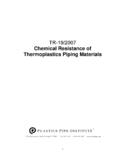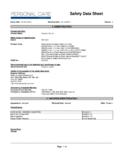Transcription of nylon flock safety data sheet - The Home of Flocking ...
1 DCA safety data sheet for Polyamide (PA ) cut flock Trade name: Polyamide ( ) Cut flock 1. Identification of substance/preparation and company/undertaking Product name: Polyamide ( ) Precision Cut flock dtex 1 - 22, cut lengths - 3 mm, raw white or dyed Producer: Various Supplier: Campbell Coutts Ltd, Unit 7 Tower Industrial Estate, Tower Lane, Eastleigh SO50 6NZ, England Tel. +44(0)23 80613700 Fax.: +44(0)23 80613355 2. Composition / information on ingredients Chemical nature: Polyamide ( ), Poly (hexamethylene adipinamide) CAS Nr. 32131-17-2 Physical nature: Cut fibres with diameters of 11 m (1 dtex) to 50 m (22 dtex) and mean length of to mm. Raw white, spundyed or bath dyed. Preparation on the fibre: inorganic and organic chemicals (total amount max. % of weight) which are indispensable for flock quality intended for electrostatic Flocking . flock black spun dyed contains about - 2 % of black pigment = Carbon Black (CI 77266) 3.
2 Hazards identification To the best of our knowledge, Polyamide flock products have not been associated with negative effects on humans if used in accordance with good industrial hygiene practice and any legal requirements. Fine dust fibres: with the above mentioned dimensions, all Cut flock Products supplied by Campbell Coutts Ltd are above the dimensions of Fine Dust Fibers which have been defined as follows *) : Diameter < 3 m, length 5 - 100 m, proportion length : diameter > 3 : 1 Deutsche Forschungsgemeinschaft DFG: MAK und BAT Werte. Verlag VCH Weinheim D 1993, p. 92 f. 4. First-aid measures Inhalation: Not specifically concerned (s. point 3) Skin contact: Not specifically concerned In case of fire, the molten product may cause burns. Rinse with plenty of water. Do not attempt to remove clothes (danger of adherence to the skin). Call for a physician. Eye contact: Not specifically concerned Ingestion: Not specifically concerned DCA 5.
3 Fire-fighting measures Fire extinguishing agents: All usual extinguishing media may be used Restrictions: No restrictions Specific information for fire-fight: Use autonomous respirators to fight fire indoor or in poorly ventilated areas. Do not use water as extinguishing agent in the presence of uninterrupted electrical installations. Hazardous decomposition products: Depending on temperature and oxygen availability, combustion off-gases contain variable quantities of toxic substances ( carbon monoxide, hydrogen cyanide, various organic compounds) which must not be inhaled. 6. Accidental release measures Accidental dispersion/spill: Collect material for controlled re-use or waste disposal. No special safety risks or risks to the environment. 7. Handling and storage Fire precautions: Remove dust, fly and finish residues by ventilation and vacuum cleaning, especially on heat setting operations. Keep away from ignition sources.
4 Beware of static electricity and discharges (s. point 9) Storage: No special safety precautions Storage conditions: Consider technical advices referring to optimal processability 8. Exposure controls and personal protection Components with occupational exposure limits: none Industrial hygiene: No special risks if handled in accordance with good industrial hygiene practice and any legal requirements. Personal protection: Dust mask, protecting goggles 9. Physical and chemical properties: Appearance: Form: short fibres Colour: raw white, or dyed Odour: none Melting range: [ C]: 250-260 Flash point: [ C]: about 400 Ignition temperature: [ C]: about 450 Thermal decomposition: [ C]: starts at about 350 Explosion limits: Cut flock / air mixtures may be exposable within certain concentration limits and sufficiently high ignition energies (dust explosion class 1, Kst-value >0 to 200 bar*m*s-1).
5 Electrostatic Flocking installations with an electric discharge energy > 500 mJ show a lower explosion limit of > 125 g flock / m3 of air. S. Journal flock , Dec. 1983, p. 4 - 10 Density: [g/cm3]: - Apparent density: [kg/m3] 50 - 200 Vapor pressure: not applicable Solubility in water: flock products are not water soluble DCA 10. Stability and reactivity Conditions to avoid: none under normal storage conditions Materials to avoid: none under normal storage conditions Hazardous decomposition products: none under normal storage conditions Combustion off-gases see point 5. 11. Toxicological information The fibre product does not present special risks on humans if used in accordance with good Industrial hygiene practice and the concerning legal requirements. 12. Ecological information The fibre product is not associated with ecological problems, provided that the wastes are orderly disposed of.
6 Because of its chemical nature, the product is not ecotoxic and not readily biodegradable. 13. Disposal considerations Can be disposed of as solid waste or burned in suitable installations, subject to local regulations. 14. Transport information International regulation: Class RID/ADR: not classified as hazardous Class ICAO/IATA: not classified as hazardous Class OMI/IMDG: not classified as hazardous 15. Regulatory information Classification and labeling Not classified as hazardous (regulation EEC and others) 16. Other information This safety data sheet uses the format and listing sequence of Commission Directive 91/155/EEC though the described product is not a dangerous preparation. It is intended to inform about physical properties, safety aspects, toxicological data and ecological characteristics that are relevant for the use of synthetic fibres in textile, technical and industrial applications, and to recommend procedures for their handling, storage and transport.
7 This safety data sheet is a complement to Technical data Sheets but does not replace them. The information given is to the best of our knowledge at the date of issue. It does not constitute a contractual description of product properties. The safety data sheet is not meant to be handed out to private end-users. The safety data sheet does not disengage the user of his duty to know and to apply any law and regulation that may be relevant.






